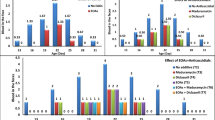Abstract
A NUTRITIONAL disease of chicks characterised by subcutaneous, intramuscular and abdominal hæmorrhages, prolonged blood-clotting time and erosions of the gizzard lining has been described in detail by Hoist and Halbrook1 of this laboratory. They were able to cure the disease by the use of fresh cabbage. The gizzard erosions and bleeding tendencies have been noted by McFarlane, Graham and Hall2. Dam and Schönheyder3 have also produced the hæmorrhagic symptoms in chicks, and have shown that the disease is not caused by lack of any of the known vitamins. The same finding has been obtained by Halbrook4.
This is a preview of subscription content, access via your institution
Access options
Subscribe to this journal
Receive 51 print issues and online access
$199.00 per year
only $3.90 per issue
Buy this article
- Purchase on SpringerLink
- Instant access to full article PDF
Prices may be subject to local taxes which are calculated during checkout
Similar content being viewed by others
References
W. F. Holst and E. R. Halbrook, Science, 77, 354; 1933.
W. D. McFarlane, W. R. Graham, Jr., and G. E. Hall, J. Nutrit., 4, 331; 1931.
H. Dam and F. Schönheyder, Biochem. J., 28, 1355; 1934.
E. R. Halbrook, Thesis, University of California; 1935.
H. Dam, NATURE, 135, 652, April 27, 1935.
R. Cribbett, and J. T. Correll, Science, 79, 40; 1934.
Author information
Authors and Affiliations
Rights and permissions
About this article
Cite this article
ALMQUIST, H., STOKSTAD, E. Dietary Hæmorrhagic Disease in Chicks. Nature 136, 31 (1935). https://doi.org/10.1038/136031b0
Issue date:
DOI: https://doi.org/10.1038/136031b0
This article is cited by
-
Post-translational carboxylation of preprothrombin
Molecular and Cellular Biochemistry (1981)
-
Vitamins K
Ergebnisse der Physiologie Biologischen Chemie und Experimentellen Pharmakologie (1940)
-
Fortschritte in der Physiologie der Blutgerinnung
Ergebnisse der Physiologie Biologischen Chemie und Experimentellen Pharmakologie (1940)



